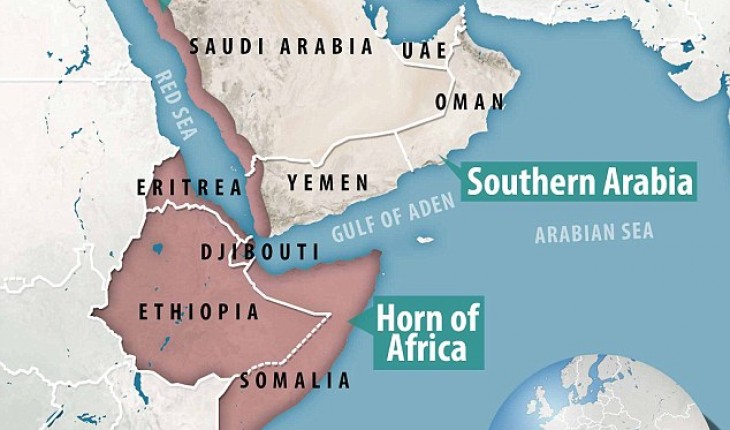- 20,000 years ago, people clustered in the South Arabia region
- Researchers found this by examining a rare mitochondrial DNA lineage
- Findings show humans lived in the area 10,000 years earlier than thought
By Abigail Beall For Mailonline
The last Ice Age made much of the globe uninhabitable, but there were oases – or refugia – where populations managed to survive.
By studying a rare DNA lineage, researchers have discovered that one of these shelters existed in what is now Southern Arabia.
The findings prove humans were in Southern Arabia 10,000 years earlier than first thought.

A group from the University of Huddersfield has found humans were in Southern Arabia 10,000 years earlier than first thought. Purple region shows density of population in Arabia and Hook of Africa 29,000 years ago
A group from the University of Huddersfield, specialising in the analysis of human DNA, found new evidence there was one or more of these shelters in what is now Southern Arabia.
South Arabia is a historical region consisting of the southern region of the Arabian Peninsula, mainly centered in what is now the Republic of Yemen.
The researchers studied a rare mitochondrial DNA lineage named R0a, which, uniquely, is most frequent in Arabia and the Horn of Africa.
Mitochondrial DNA is passed from mothers to their children.
‘We basically collected a group of mitochondrial DNA (mtDNA) that shared some specific mutations, thus belonging to the same “haplogroup”,’ lead researcher Dr Francesca Gandini told MailOnline.
‘We completely sequenced these mtDNAs, looked at their geographic origin and applied the so called “molecular clock” to calculate when these haplogroup originated.
‘The results allowed us to hypothesize that the first members of this lineage, called R0a, were already present in Southern Arabia before the last Ice Age, and thus they probably survived during the Glacial Maximum in one or more oases, or “refugia”.’
They found 20,000 years ago, during the last Ice Age also known as the Pleistocene glaciation, people clustered in the region.
After this, around 15,000 years ago when the Ice Age had receded, the people in this refugium disappeared.
They populated Arabia and the Horn of Africa, and may have also ventured further afield according to the researchers.
Dr Gandini and her co-researchers found the lineage is more ancient than previously thought and it has a deeper presence in Arabia than was earlier believed.
If the people survived the Ice Age in the region, it means there was a refugium there during the Pleistocene period, which spanned the Ice Age.

It had been previously believed people did not settle in large numbers in Arabia until the development of agriculture, around 10 to 11,000 years ago.
The researchers added there is evidence for the movement of people in the R0a group through the Middle East and into Europe.
They said there might also have been a trading network and a ‘gene flow’ from Arabia into the territories that are now Iran, Pakistan and India.



Around 15,000 years ago, after the Ice Age had receded, the people in the refugium disappeared. They populated Arabia and the Horn of Africa (pictured 10,000 years ago, left and 4,000 years ago, right) and may have also ventured further afield according to the researchers
Archaeological studies previously found modern humans swept into Europe 45,000 years ago.
This ultimately led to the demise of the Neanderthals, despite the fact some modern humans interbred with these cousins.
During the Ice Age that ended 12,000 years ago, with its peak between 25,000 and 19,000 years ago when the melt started, glaciers covered Scandinavia and northern Europe all the way to northern France.
As the ice sheets retreated at the end of the last Ice Age, the region was repopulated.
Research published last week revealed the most detailed genetic analysis of Upper Paleolithic Europeans to date and discovered a major new lineage of early modern humans.
Professor David Reich and his colleagues from Harvard University analysed genome-wide data from 51 modern humans who lived between 45,000 and 7,000 years ago to study this repopulation.
Remains found from this period include three 31,000-year-old skulls from Dolni Věstonice in the Czech Republic, the lower jaw of the 19,000-year-old ‘Red Lady of El Mirón Cave’ and the skull of a 14,000-year-old individual discovered at the Villabruna in northeastern Italy, among others.
The genetic data shows, beginning 37,000 years ago, all Europeans come from a single founding population that persisted through the Ice Age.
The founding population has deep branches in different parts of Europe, one of which is represented by a specimen from Belgium.
In fact, present-day Europeans can trace their ancestry back to this group of humans who lived in northwest Europe 35,000 years ago.




